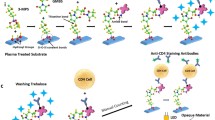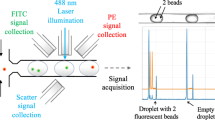Abstract
Micro-fabrication technology has substantial potential for identifying molecular markers expressed on the surfaces of tissue cells and viruses. It has been found in several conceptual prototypes that cells with such markers are able to be captured by their antibodies immobilized on microchannel substrates and unbound cells are flushed out by a driven flow. The feasibility and reliability of such a microfluidic-based assay, however, remains to be further tested. In the current work, we developed a microfluidic-based system consisting of a microfluidic chip, an image grabbing unit, data acquisition and analysis software, as well as a supporting base. Specific binding of CD59-expressed or BSA-coupled human red blood cells (RBCs) to anti-CD59 or anti-BSA antibody-immobilized chip surfaces was quantified by capture efficiency and by the fraction of bound cells. Impacts of respective flow rate, cell concentration, antibody concentration and site density were tested systematically. The measured data indicated that the assay was robust. The robustness was further confirmed by capture efficiencies measured from an independent ELISA-based cell binding assay. These results demonstrated that the system developed provided a new platform to effectively quantify cellular surface markers effectively, which promoted the potential applications in both biological studies and clinical diagnoses.
Similar content being viewed by others
References
Yamada K M. Cell surface marker for malignancy. Nature, 1978, 273: 335–336 661945, 10.1038/273335a0, 1:STN:280:DyaE1c7pvFOmtA%3D%3D
Warnke R A, Link M P. Identification and significance of cell markers in leukemia and lymphoma. Annu Rev Med, 1983, 34: 117–131 6407386, 10.1146/annurev.me.34.020183.001001, 1:STN:280:DyaL3s3ivFGjsQ%3D%3D
Long M, Zhao H, Huang K S, et al. Kinetic measurements of cell surface E-selectin/carbohydrate ligand interactions. Ann Biomed Eng, 2001, 29: 935–946 11791676, 10.1114/1.1415529, 1:STN:280:DC%2BD38%2Fmslarsg%3D%3D
Huang J, Chen J, Chesla S E, et al. Quantifying the effects of molecular orientation and length on two-dimensional receptor-ligand binding kinetics. J Biol Chem, 2004, 279: 44915–44923 15299021, 10.1074/jbc.M407039200, 1:CAS:528:DC%2BD2cXosFymurg%3D
Yang X Y, Chen E, Jiang H, et al. Development of a quantitative cell-based ELISA, for a humanized anti-IL-2/IL-15 receptor beta antibody (HuMikbeta(1)), and correlation with functional activity using an antigen-transfected murine cell line. J Immunol Methods, 2006, 311: 71–80 16564055, 10.1016/j.jim.2006.01.014, 1:CAS:528:DC%2BD28XjvVGmsbw%3D
Belov L, de la Vega O, dos Remedios C G, et al. Immunophenotyping of leukemias using a cluster of differentiation antibody microarray. Cancer Res, 2001, 61: 4483–4489 11389079, 1:CAS:528:DC%2BD3MXktlWjs7w%3D
Belov, L, Huang, P, Barber, N, et al. Identification of repertoires of surface antigens on leukemias using an antibody microarray. Proteomics, 2003, 3: 2147–2154. 14595814, 10.1002/pmic.200300599, 1:CAS:528:DC%2BD3sXptFKqtLc%3D
Campbell C J, O’Looney N, Chong Kwan M, et al. Cell interaction microarray for blood phenotyping. Anal Chem, 2006, 78: 1930–1938 16536430, 10.1021/ac051651m, 1:CAS:528:DC%2BD28XhtFSksr8%3D
Ko I K, Kato K, Iwata H. Antibody microarray for correlating cell phenotype with surface marker. Biomaterials, 2005, 26: 687–696 15282147, 10.1016/j.biomaterials.2004.03.014, 1:CAS:528:DC%2BD2cXmtFCntbg%3D
Woolfson A, Stebbing J, Tom B D M, et al. Conservation of unique cell-surface CD antigen mosaics in HIV-1-infected individuals. Blood, 2005, 106: 1003–1007 15827132, 10.1182/blood-2004-12-4642, 1:CAS:528:DC%2BD2MXntVSmsr8%3D
Zhu H, Snyder M. Protein chip technology. Curr Opin Chem Biol, 2003, 7: 55–63 12547427, 10.1016/S1367-5931(02)00005-4, 1:CAS:528:DC%2BD3sXltlaqtA%3D%3D
Casciano D A, Woodcock J. Empowering microarrays in the regulatory setting. Nat Biotechnol, 2006, 24: 1103 16964221, 10.1038/nbt0906-1103, 1:CAS:528:DC%2BD28XptlSls7g%3D
Kling J. Moving diagnostics from the bench to the bedside. Nat Biotechnol, 2006, 24: 891–893 16900120, 10.1038/nbt0806-891, 1:CAS:528:DC%2BD28XnvVygsLw%3D
Whitesides G M. The origins and the future of microfluidics. Nature, 2006, 442: 368–373 16871203, 10.1038/nature05058, 1:CAS:528:DC%2BD28XnsVaju74%3D
Mitchell P. Microfluidics-downsizing large-scale biology. Nat Biotechnol, 2001, 19: 717–721 11479557, 10.1038/90754, 1:CAS:528:DC%2BD3MXlsleksLg%3D
Bange A, Halsall H B, Heineman W R. Microfluidic immunosensor systems. Biosens Bioelectron, 2005, 20: 2488–2503 15854821, 10.1016/j.bios.2004.10.016, 1:CAS:528:DC%2BD2MXjs1Knt7c%3D
Bernard A, Michel B, Delamarche E. Micromosaic immunoassays. Anal Chem, 2001, 73: 8–12 11195515, 10.1021/ac0008845, 1:CAS:528:DC%2BD3cXnvFart7Y%3D
Eteshola E, Balberg M. Microfluidic ELISA: on-chip fluorescence imaging. Biomed Microdevices, 2004, 6: 7–9 15307439, 10.1023/B:BMMD.0000013360.65653.c2, 1:CAS:528:DC%2BD2cXms1eqsQ%3D%3D
Jiang X, Ng J M, Stroock A D, et al. A miniaturized, parallel, serially diluted immunoassay for analyzing multiple antigens. J Am Chem Soc, 2003, 125: 5294–5295 12720439, 10.1021/ja034566+, 1:CAS:528:DC%2BD3sXivVClsbc%3D
Lai S, Wang S, Luo J, et al. Design of a compact disk-like microfluidic platform for enzyme-linked immunosorbent assay. Anal Chem, 2004, 76: 1832–1837 15053640, 10.1021/ac0348322, 1:CAS:528:DC%2BD2cXhsVKks7k%3D
Mao H, Yang T, Cremer P S. Design and characterization of immobilized enzymes in microfluidic systems. Anal Chem, 2002, 74: 379–385 11811412, 10.1021/ac010822u, 1:CAS:528:DC%2BD3MXovFalsb4%3D
Lin C C, Chen A, Lin C H. Microfluidic cell counter/sorter utilizing multiple particle tracing technique and optically switching approach. Biomed Microdevices, 2008, 10: 55–63 17659444, 10.1007/s10544-007-9109-8
Wolff A, Perch-Nielsen I R, Larsen U D, et al. Integrating advanced functionality in a microfabricated high-throughput fluorescentactivated cell sorter. Lab Chip, 2003, 3: 22–27 15100801, 10.1039/b209333b, 1:CAS:528:DC%2BD3sXht1Kru7s%3D
Du Z, Colls N, Cheng K H, et al. Microfluidic-based diagnostics for cervical cancer cells. Biosens Bioelectron, 2006, 21: 1991–1995 16242927, 10.1016/j.bios.2005.09.005, 1:CAS:528:DC%2BD28XivVOis78%3D
Liu W T, Zhu L, Qin Q W, et al. Microfluidic device as a new platform for immunofluorescent detection of viruses. Lab Chip, 2005, 5: 1327–1330 16234960, 10.1039/b509086e, 1:CAS:528:DC%2BD2MXhtFCntb%2FE
Davies A, Lachmann P J. Membrane defence against complement lysis: the structure and biological properties of CD59. Immunol Res, 1993, 12: 258–275 7507156, 10.1007/BF02918257, 1:CAS:528:DyaK2cXitFClsL8%3D
Kofler R, Wick G. Some methodologic aspects of the chromium chloride method for coupling antigen to erythrocytes. J Immunol Methods, 1977, 16: 201–209 326970, 10.1016/0022-1759(77)90198-3, 1:CAS:528:DyaE2sXltFKiu7w%3D
Chesla S E, Selvaraj P, Zhu C. Measuring two-dimensional receptor-ligand binding kinetics by micropipette. Biophys J, 1998, 75: 1553–1572 9726957, 10.1016/S0006-3495(98)74074-3, 1:CAS:528:DyaK1cXlvVCqs70%3D
Wu L, Xiao B, Jia X, et al. Impact of carrier stiffness and microtopology on two-dimensional kinetics of P-selectin and P-selectin glycoprotein ligand-1 (PSGL-1) interactions. J Biol Chem, 2007, 282: 9846–9854 17267403, 10.1074/jbc.M609219200, 1:CAS:528:DC%2BD2sXjtlCiu7w%3D
Duffy D C, McDonald J C, Schueller O J A, et al. Rapid prototyping of microfluidic systems in Poly(dimethylsiloxane). Anal Chem, 1998, 70: 4974–4984 10.1021/ac980656z, 1:CAS:528:DyaK1cXmslyitbg%3D
Zhang Z L, Crozatier C, Le Berre M, et al. In situ biofunctionalization and cell adhesion in microfluidic devices. Microelectron Eng, 2005, 78–79: 556–562 10.1016/j.mee.2004.12.071
Selvaraj P, Plunkett M L, Dustin M, et al. The T lymphocyte glycoprotein CD2 binds the cell surface ligand LFA-3. Nature, 1987, 326: 400–403 2951597, 10.1038/326400a0, 1:CAS:528:DyaL2sXhslChurk%3D
Ali M K, Bergson C. Elevated intracellular calcium triggers recruitment of the receptor cross-talk accessory protein calcyon to the plasma membrane. J Biol Chem, 2003, 278: 51654–51663 14534309, 10.1074/jbc.M305803200, 1:CAS:528:DC%2BD3sXpslOgsL8%3D
Borroto A, Ruiz-Paz S, de la Torre T V, et al. Impaired trafficking and activation of tumor necrosis factor-alpha-converting enzyme in cell mutants defective in protein ectodomain shedding. J Biol Chem, 2003, 278: 25933–25939 12714588, 10.1074/jbc.M301673200, 1:CAS:528:DC%2BD3sXlt1Clsbs%3D
Freedman A S. Cell surface antigens in leukemias and lymphomas. Cancer Invest, 1996, 14: 252–276 8630688, 10.3109/07357909609012148, 1:CAS:528:DyaK28XjslCitb8%3D
Chang T W. Binding of cells to matrixes of distinct antibodies coated on solid surface. J Immunol Methods, 1983, 65: 217–223 6606681, 10.1016/0022-1759(83)90318-6, 1:STN:280:DyaL2c%2FovFSntA%3D%3D
Author information
Authors and Affiliations
Corresponding author
Additional information
Supported by the National Key Basic Research Program of China (Grant No. 2006CB910303), National Natural Science Foundation of China (Grant Nos. 30730032 and 10332060), National High-Tech Research and Development Program of China (Grant No. 2007AA02Z306) and Chinese Academy of Sciences Grant (Grant No.2005-1-16)
Rights and permissions
About this article
Cite this article
Yang, F., Gao, Y., Zhang, Y. et al. Developing a microfluidic-based system to quantify cell capture efficiency. SCI CHINA SER C 52, 173–181 (2009). https://doi.org/10.1007/s11427-009-0017-4
Received:
Accepted:
Published:
Issue Date:
DOI: https://doi.org/10.1007/s11427-009-0017-4




